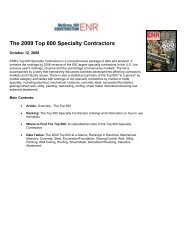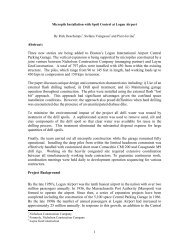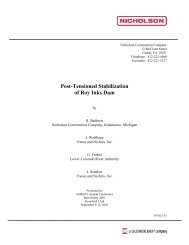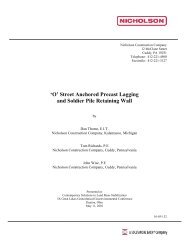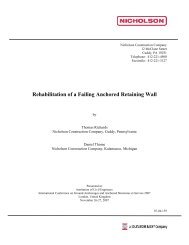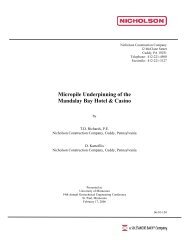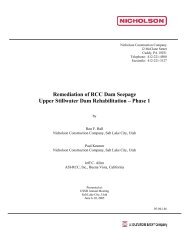Strain Gauges in Micropiles - Nicholson Construction Company
Strain Gauges in Micropiles - Nicholson Construction Company
Strain Gauges in Micropiles - Nicholson Construction Company
- No tags were found...
Create successful ePaper yourself
Turn your PDF publications into a flip-book with our unique Google optimized e-Paper software.
Precautions that should be taken dur<strong>in</strong>g <strong>in</strong>stallation <strong>in</strong>clude:• Label all wires ( most <strong>in</strong>strument manufacturers assign a serial number to eachgauge and provide a label of the serial number on the wire)• Do not proceed without the special vibrat<strong>in</strong>g wire gauge measurement unit(typically the readout box) and be sure to have the readout box <strong>in</strong> the propersett<strong>in</strong>g,• Read the gauges as delivered and compare read<strong>in</strong>gs to factory zero read<strong>in</strong>gs,• Layout the gauges on the bar at the desired location,• Modify the gauge locations as necessary with the as-built pile. Try to place thebar <strong>in</strong> the same cross section of the pile and avoid alignment with cas<strong>in</strong>g jo<strong>in</strong>ts.• Note the gauge serial number and as-built location ,• Zip tie or duct tape the read<strong>in</strong>g wires to the sister bar with a little slack <strong>in</strong> thecable us<strong>in</strong>g care to not cut the wire. This will avoid pull<strong>in</strong>g on at thewire/gauge connection.• Tiewire the gauges to the pile re<strong>in</strong>forc<strong>in</strong>g bar and read aga<strong>in</strong> and compare tofactory zero,• Modify centralizer locations near the gauge (do not let centralizer locationchange the target location of the gauge),• While plac<strong>in</strong>g the pile re<strong>in</strong>forc<strong>in</strong>g bar down the pile, zip tie or duct tape theread<strong>in</strong>g wires to the bar us<strong>in</strong>g care to not cut the wire and not allow bulges <strong>in</strong>the wires that could get cut at p<strong>in</strong>ch po<strong>in</strong>ts (bar couplers or cas<strong>in</strong>g threads),• Use plenty of bar centralizers and run the wires through the centralizers, not onthe outer edge of the centralizers• Do not cut the wires without relabell<strong>in</strong>g which gauge serial number on thewire,• Obta<strong>in</strong> read<strong>in</strong>gs <strong>in</strong>itially after gauge placement and grout<strong>in</strong>g, dur<strong>in</strong>g grouthydration, and after grout is hard,• Prior to test<strong>in</strong>g, put a nut on the bar with the upper face <strong>in</strong> the plane of thecas<strong>in</strong>g edge, fill the entire annulus with grout and place the bear<strong>in</strong>g plate ontop. This will improve the even load<strong>in</strong>g of the <strong>in</strong>ner rod, the grout and thecas<strong>in</strong>g and the evaluation of composite modulus. This is discussed furtherbelow regard<strong>in</strong>g Figure 7.Most manufacturers’ literature recommend aga<strong>in</strong>st hang<strong>in</strong>g the sister bars from theelectrical wire. However, <strong>in</strong> piles without a central bar, we have successfully <strong>in</strong>sertedthe gauges after neat cement grout<strong>in</strong>g by duct-tap<strong>in</strong>g the wire to the sister bars (toavoid tension at the connection), then lower<strong>in</strong>g with the wire ( See Figure 1) andhang<strong>in</strong>g the sister bar from the wire.Most gauges also have a temperature sensor. It is <strong>in</strong>terest<strong>in</strong>g to see how hot the groutgets. On one project, the grout <strong>in</strong>side 7 <strong>in</strong>ch cas<strong>in</strong>g reached a temperature of over 100deg C and gauges appeared to have functioned fairly well dur<strong>in</strong>g the load test.MeasurementThe stra<strong>in</strong> gauges arrive factory calibrated. <strong>Stra<strong>in</strong></strong> read<strong>in</strong>gs can be recorded manuallyus<strong>in</strong>g a digital readout unit or automatically with a data logger. The stra<strong>in</strong> gauges aretypically connected to a junction box. For manual read<strong>in</strong>gs, a switch box can be usedto read each gauge sequentially us<strong>in</strong>g the digital readout unit. Alternatively, the data



